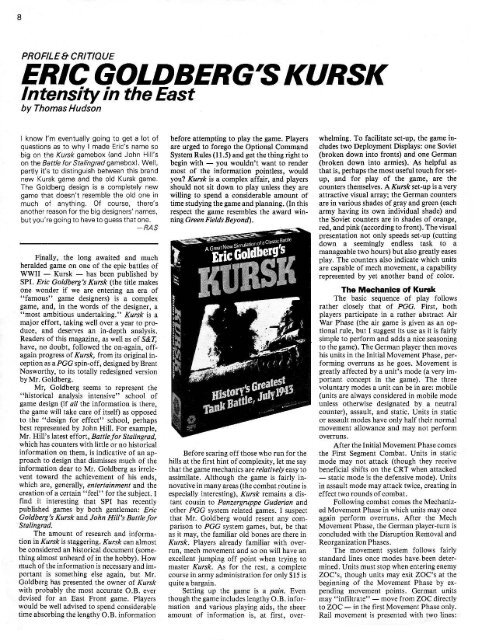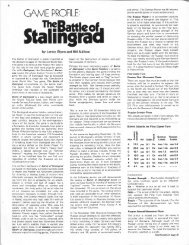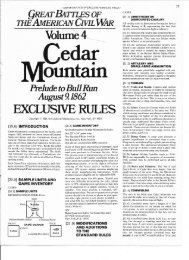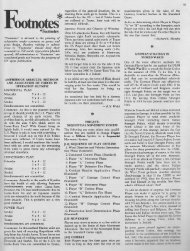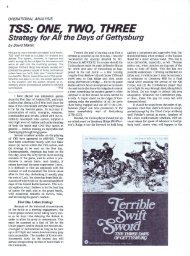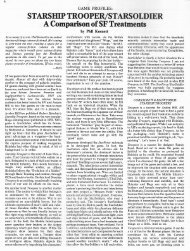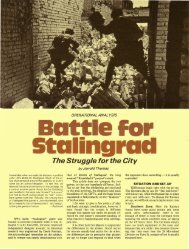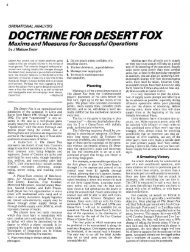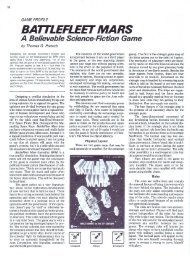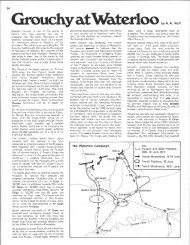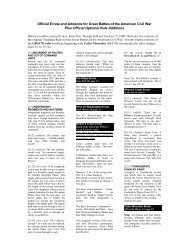ERIC GOLDBERG'S KURSK - RussGifford.net
ERIC GOLDBERG'S KURSK - RussGifford.net
ERIC GOLDBERG'S KURSK - RussGifford.net
- No tags were found...
You also want an ePaper? Increase the reach of your titles
YUMPU automatically turns print PDFs into web optimized ePapers that Google loves.
8PROFILE & CRITIQUE<strong>ERIC</strong> <strong>GOLDBERG'S</strong> <strong>KURSK</strong>Intensity in the Eastby Thomas HudsonI know I'm eventually going to get a lot ofquestions as to why I made Eric's name sobig on the Kursk gamebox (and John Hill'son the BarrIe for Stalingrad gameboxl. Well,partly it's to distinguish between this brandnew Kursk game and the old Kursk game.The Goldberg design is a completely newgame that doesn't resemble the old one inmuch of anything. Of course, there'sanother reason for the big designers' names,but you're going to have to guess that one.-RASFinally, the long awaited and muchheralded game on one of the epic battles ofWWII - Kursk - has been published bySPI. Eric Goldberg's Kursk (the title makesone wonder if we are entering an era of"famous" game designers) is a complexgame, and, in the words of the designer, a"most ambitious undertaking." Kursk is amajor effort, taking well over a year to produce,and deserves an in-depth analysis.Readers of this magazine, as well as of S&1:have, no doubt, followed the on-again, offagainprogress of Kursk, from its original inceptionas a PGG spin-off, designed by BrentNosworthy, -to its totally redesigned versionby Mr. Goldberg.Mr, Goldberg seems to represent the"historical analysis intensive" school ofgame design (if all the information is there,the game will take care of itself) as opposedto the " design for effect" school, perhapsbest represented by John Hill. For example,Mr. Hill's latest effort, Battlejor Stalingrad,which has counters with little or no historicalinformation on them, is indicative of an approachto design that dismisses much of theinformation dear to Mr. Goldberg as irreleventtoward the achievement of his ends,which are, generally, entertainment and thecre.ation ·of a certain "feel" for the subject. Ifind it interesting that SPI has recentlypublished games by both gentlemen: EricGoldberg's Kursk and John Hill's BattlejorStalingrad.The amount of research and informationin Kursk is staggering. Kursk can almostbe considered an historical document (somethingalmost unheard of in the hobby). Howmuch of the information is necessary and importantis something else again, but Mr.Goldberg has presented the owner of Kurskwith probably the most accurate O.B. everdevised for an East Front game. Playerswould be well advised to spend considerabletime absorbing the lengthy O.B. informationbefore attempting to play the game. Playersare urged to forego the Optional CommandSystem Rules (11.5) and get the thing right tobegin with - you wouldn't want to rendermost of the information pointless, wouldyou? Kursk is a complex affair, and playersshould not sit down to play unless they arewilling to spend a considerable amount oftime studying the game and planning. (In thisrespect the game resembles the award winningGreen Fields Beyond).Before scaring off those who run for thehills at the first hint of complexity, let me saythat the game mechanics are relatively easy toassimilate. Although the game is fairly innovativein many areas (the combat routine isespecially interesting), Kursk remains a distantcousin to Panzergruppe Guderian andother PGG system related games. I suspectthat Mr. Goldberg would resent any comparisonto PGG system games, but, be thatas it may, the familiar old bones are there inKursk. Players already familiar with overrun,mech movement and so on will have anexcellent jumping off point when trying tomaster Kursk. As for the rest, a completecourse in army administration for only $15 isquite a bargain.Setting up the game is a pain. Eventhough the game includes lengthy O.B. informationand various playing aids, the sheeramount of information is, at first, overwhelming.To facilitate set-up, the game includestwo Deployment Displays: one Soviet(broken down into fronts) and one German(broken down into armies). As helpful asthat is, perhaps the most useful touch for setup,and for play of the game, are thecounters themselves. A Kursk set-up is a veryattractive visual array; the German countersare in various shades of gray and green(eacharmy having its own individual shade) andthe Soviet counters are in shades of orange,red, and pink (according to front). The visualpresentation not only speeds set-up (cuttingdown a seemingly endless task to amanageable two hours) but also greatly easesplay. The counters also indicate which unitsare capable of mech movement, a capabilityrepre,sented by yet another band of color.The Mechanics of KurskThe basic sequence of play followsrather closely that of PGG. First, bothplayers participate in a rather abstract AirWar Phase (the air game is given as an optionalrule, but I suggest its use as it is fairlysimple to perform and adds a nice seasoningto the game). The German player then moveshis units in the Initial Movement Phase, performingoverruns as he goes. Movement isgreatly affected by a unit's mode (a very im·portant concept in the game). The threevoluntary modes a unit can be in are: mobile(units are always considered in mobile modeunless otherwise designated by a neutralcounter), assault, and static. Units in staticor assault modes have only half their normalmovement allowance and may not performoverruns.After the Initial Movement Phase comesthe First Segment Combat. Units in staticmode may not attack (though they receivebeneficial shifts on the CRT when attacked- static mode is the defensive mode). Unitsin assault mode may attack twice, creating ineffect two rounds of combat.Following combat comes the MechanizedMovement Phase in which units may onceagain perform overruns. After the MechMovement Phase, the German player-turn isconcluded with the Disruption Removal andReorganization Phases.The movement system follows fairlystandard lines once modes have. been determined.Units must SLOp when entering enemyZOC's, though units may exit ZOC's at thebeginning of the Movement Phase by expendingmovement points. German unitsmay "infiltrate" - move from zoe directlyto zoe - in the first Movement Phase only.Rail movement is presented with two lines:
10game-turn until game-turn 8. This is anotherdilemma for the German player (choices likethis are always desirable in a game) - to activateor not to activate.Practically all of the Soviet reinforcementsare conditional, and predicatedon German actions. Soviet reinforcementsare activated if the German player capturesvarious cities (including Lgov and Kursk)and if a German unit enters a "trigger" hex.Trigger hexes are a line of hexes that runbehind the Soviet front line, generally at adistance of th~ee to four hexes.Kursk and Lgov are in the center of ahuge pocket (The Kursk Pocket), surroundedon three sides by German units. The Germanshave three powerful panzer armies onthe south facing a relatively weak force in theVoronezh Front. On the north the Germansare strong too, but face a powerful defensiveforce in the Central Front troops. As thegame is only nine game-turns long, my initialplan was to attack hard almost the entirelength of the front, especially at the bases ofthe pocket, both in an attempt to reduce itand, in the process, perhaps destroy the entireSoviet Army. The Soviet fo rces outsidethe pocket were not inconsiderable and hadto be kept in mind.The German player has a slight edge inthe initial set-up because the Soviet playermust deploy his units first, thereby letting theGerman player know the modes of his opponentbefore he deploys. B.F. (my opponent)deployed his units in the pocket in staticmode, those a little farther away in mobilemode and those farthest away in assaultmode. On the first Game-Turn I placed allbu t those units farthest away from the pocketin assault mode. The rest I placed in mobilemode.On Game-Turn one, I attacked all alongthe line in a manner that sent paroxysms ofglee through B.F. One lesson I learned immediatelywas: mass. MASS! In order forany attack to be effective, the weight of attackmust be massed at key locations.Another quick lesson was that players shouldgenerally mix the modes of their units andkeep some units in mobile mode; it'sdelightful to be able to soften up the defensewith overruns. A related point is that antitankunits are quite brittle defending againstoverruns. Surprisingly, I made some progressagainst the northern side of the pocket, capturingDmitriyev-L'gorsky and destroyingthe 60/ CF HQ. The progress I mad,e againstthe northern side of the pocket I attribute toB.F. 's somewhat poor deployment. B.F. didnot stack his weaker units (admittedly the appearanceof Soviet strength on this front is illusionary),and because of the nature of thedefense system, stacks with low step value ac. tually help the attacker.As it turned out, the cost for my successin the north was steep. To gain weight for myattacks around Olkhovatka, I had strippedmy lines around Ore!. The result was avicious Soviet counterattack. Luckily, B.F.couldn' t take full advantage of my blunderbecause most of his units were weak. Thecounterattack didn't reach Ore!.In the south I made good progress,reaching to within one hex of Oboyan. I hadinitially decided to let the sleeping giant lieand not drive toward locales that would triggerSoviet reserves - except those locales inthe pocket itsel f: Kursk, Lgov and Oboyan.I almost panicked when the Sovietplayer counterattacked toward Kharkovwhile my units melt away. The Soviet attackreached to within two hexes of Kharkov.On Game-Turn Two, I had mixed success:I captured Oboyan, Lgov and reachedto within two hexes of Kursk. However,some of the· blunders I made on the firstGame-Tum came back to haunt me. B.F.was able to cut me up pretty bad aroundOboyan and actually drove me out of the city,though with very heavy losses. He continuedto attack in the Ore I area but he calledoff his attacks around Kharkov, throwingthose forces into the fight around Belgorod.On Game-Turn Three, I retook Oboyanand came to within one hex of Kursk, at acost that proved to be disastrous. B.F.almost eliminated my entire force aroundKursk, destroying three whole divisions! Heretook Oboyan in decisive fashion, althoughhis drive to retake Lgov proved to be ineffective.Seeing that I had stripped my northernline in order to defend Orel, B.F. attackedtoward Bryansk. His initial success almostdevastated me, but luckily the Soviet forceswere weak. Another lesson learned.On Game-Turn Four, I was able to cutthrough and save the rest of my forcesaround Kursk. However, with the arrival oftwo Soviet reserve armies I could see thehandwriting on the wal!. I would never beable to retake Kursk and even though theSoviet losses were high, mine more than offsetthem. I conceded a tactical Soviet victory.After-Action ReportKursk is not a game with lightningpe<strong>net</strong>ration and deep thrusts; it does rewardthe careful planner. Kursk is a game that cannotbe mastered easily. A game between twoinexperienced players can be a rather dull,sloppy affair, with little action and lots ofbreaks to look up details in the rules. This isnot a criticism of the game, however. Oncemastered, the game is an absorbing and interestingsimulation, with many subtleties.One can even admire the intricate workingsof the many parts and sub-systems. The rulesare generally clear and there were no majorlapses or gliches in the rules that rendered thegame unplayable.Kursk is not a game to approach lightly;it is akin to a monster game even though ithas but one map. In our game we spent agood two hours on each game-turn, probablythe norm for even experienced players. Norcan Kursk be recommended for those thatare put off by complexity. For those who donot mind complexity and have a large chunkof time to invest in it, the game can be vastlyrewarding.A Critical AnalysisAs far as I am concerned, the designerhas indeed attained his goals. He hasgiven players a truly impressive O.B. thaImust stand as a standard of excellence in theindustry. He has created a simulation that requireshard work and rewards that work. Hehas given players a complex and intricategame that can delight those who perceive itssubtleties, and he has accomplished all thiswith great ability.For all of the game's achievements, Ican't give myself over to unq ualified praise. Ican't whip up much enthusiasm for thegame. I would guess tha.t's the way Mr.Goldberg feels about it too. I can't picturethe designer getting Kursk off his shelf toplay it .... ever. Now is that necessarily acriticism?This judgment is perhaps uncalled for,but the nature of Mr. Goldberg's achievementthrusts the game in the forefront of thehobby in many ways. With Kursk, a gamewhich is clearly state-of-the-art, one gets thefeeling that it is a competent design, a rehashof many "good" game systems, by adesigner who delights in complexity for noother reason than to display his considerabletalents. One feels that the designer wouldnever want to play this game, that for himthere are no absorbing concepts or problemsthat attract and excite him to further creation.The designer should be justly proud, inthat he has achieved his aims: layers of complexitythat do hold together. One onlyregrets that the designer (for all his ambition)set his goals too low.ErratumThe city of 8elgurod (1520) should have aVictory Point value of "2/ 10." ••Are You ChangingYour Address?If YOIl a re. YOIl must leI. us know in advance inorder to avoid missing any of your isslles ofAres, S&Tand/ or MOVES.1. Your name - as it appears on the mail inglabel of your A res, S& Tand/ or MO VES.2. Your Customer Code and Expiration Codes(this is the very lap li ne o f information on yourmailing label).3. Your old address (clearly indicate it is"old" address).4. Your new address (clearly indicate it is" new" address).5. The effective dale or your new address.When YOIl send us a ~hange of address, don'tenclose any of her ~ o rre s pondenc e that does notpertain to thal change - it just slows up theprocessing of [he change and creates apossibility of missed in formatio,n. A postcardis best. Write LO:Simulations Publications, Inc.Customer Service, COA Dept.257 Park Avenue SouthNew York. New York 10010


